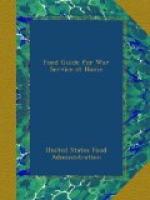We in America have no more than touched our capacity for raising gardens. What we have done is merely a beginning. As the war goes on we shall realize more and more the necessity for seizing every opportunity for active service. The accomplishments of the summer of 1917 showed the possibilities of the work, and placed it beyond the purely experimental stage. They have given experience and emphasized the value of expert advice and the economy of community efforts.
Not only is the “plant a garden” a civilian movement, but it has taken hold in the armies as well. The American Army Garden service is planning truck-gardens in France to supply our troops. The Woman’s Auxiliary Army Corps of England plants gardens back of the British lines. Last summer the French fed 20,000 of their men from similar gardens.
EVERY POUND OF FOOD GROWN IN THESE HOME AND COMMUNITY GARDENS RELIEVES THE RAILROAD CONGESTION AND GIVES MORE SPACE FOR TRANSPORTING MUNITIONS AND COAL. EVERY POUND OF FOOD GROWN RELEASES STAPLES FOR EUROPE. Extra production of food of any kind, anywhere, takes on a new significance in the presence of half a world hungry.
IF YOU CANNOT GROW VEGETABLES, USE THEM IN ABUNDANCE ANYWAY. They are too perishable to ship abroad and too bulky, containing so much water that it would be an uneconomical use of shipping to export them. But the more America eats of almost any kind of vegetable or fruit, the less of the more durable, concentrated foods will she require. The products are so varied in kind and composition that they can be used to serve almost any purpose—beans and peas to save meat; potatoes and others to save wheat; sweet fruits to save sugar; jams, even, when spread on bread, to save fat. All will improve the health and therefore increase human energies for winning the war.
IN THE WAR DIET
To Save Meat. Beans and peas and peanuts are the only vegetables with much protein, so that they are the ones thought of primarily as meat substitutes. There are many kinds of them, fresh or dried, more than most of us realize. It is worth while to add to the diet not only the ordinary white or navy beans, but kidney, lima, black or soy beans, cow-peas, the many colored beans such as the pinto, frijoles, and the California pinks. It is these latter kinds that are used by the Mexicans as their chief standby. The Army and Navy use huge quantities of the white beans, and the Allied Governments are also buying tons of the pintos.
The 1917 bean-crop, in response to the patriotic appeal, was 50 per cent higher than the normal. Nearly all this increase was in the colored beans, chiefly pintos. The Food Administration, fearing that some of this unusual surplus might be wasted and the farmer discouraged from producing a large output in 1918, bought up the extra crop and distributed it for sale at the different markets.




